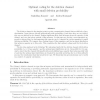TIT
2010
14 years 2 months ago
2010
The utility of limited feedback for coding over an individual sequence of DMCs is investigated. This study complements recent results showing how limited or noisy feedback can boos...
SIAMCOMP
2011
14 years 2 months ago
2011
We investigate ways in which an algorithm can improve its expected performance by fine-tuning itself automatically with respect to an arbitrary, unknown input distribution. We gi...
CORR
2011
Springer
14 years 2 months ago
2011
Springer
The deletion channel is the simplest point-to-point communication channel that models lack of synchronization. Input bits are deleted independently with probability d, and when th...
CORR
2010
Springer
14 years 7 months ago
2010
Springer
Consider the minimum mean-square error (MMSE) of estimating an arbitrary random variable from its observation contaminated by Gaussian noise. The MMSE can be regarded as a function...
NN
2002
Springer
14 years 7 months ago
2002
Springer
The ability to grow extra nodes is a potentially useful facility for a self-organising neural network. A network that can add nodes into its map space can approximate the input sp...
COMPGEOM
2008
ACM
14 years 9 months ago
2008
ACM
We study the problem of two-dimensional Delaunay triangulation in the self-improving algorithms model [1]. We assume that the n points of the input each come from an independent, ...
ICC
2007
IEEE
15 years 1 months ago
2007
IEEE
— Discrete input distributions are capacity-achieving for a variety of noise distributions whenever the input is subject to peak power or other bounding constraints. In this pape...

